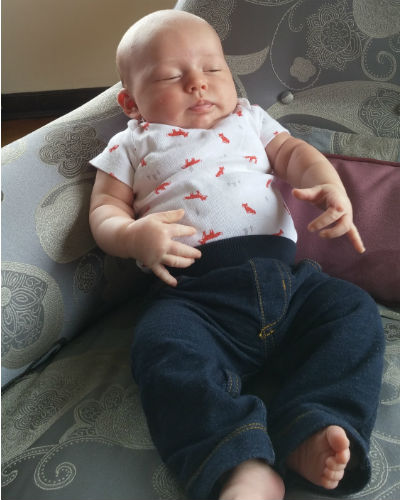 This year, more than 4 million babies will be born in America. Three weeks ago, one of my colleagues gave birth to one of them, named Flint, whom we got to see for the first time when he made a live cameo with his mother on a team video conference. Only wearing his diapers, Flint looked playful, happy and, most importantly, healthy. Over the next few years, Flint will deal with his share of illnesses as his body’s immune system develops. One of the major health concerns for Flint, however, will have no initial symptoms and cause no discomfort, but if not prevented, it could have serious long-term health consequences. This hidden danger is childhood obesity, and it’s time for disruptive forces to address this epidemic.
This year, more than 4 million babies will be born in America. Three weeks ago, one of my colleagues gave birth to one of them, named Flint, whom we got to see for the first time when he made a live cameo with his mother on a team video conference. Only wearing his diapers, Flint looked playful, happy and, most importantly, healthy. Over the next few years, Flint will deal with his share of illnesses as his body’s immune system develops. One of the major health concerns for Flint, however, will have no initial symptoms and cause no discomfort, but if not prevented, it could have serious long-term health consequences. This hidden danger is childhood obesity, and it’s time for disruptive forces to address this epidemic.
According to the Center for Disease Control and Prevention (CDC), more than a third of American children are overweight, and several studies have suggested there’s a strong link between childhood obesity and adult obesity. It’s important to note that obesity is a major health concern because it is often the trigger for other deadly and costly diseases such as diabetes and heart diseases. Now, with nearly 70% of American adults considered overweight, obesity is rapidly becoming a major epidemic, with an annual cost to America’s health system that is estimated to be between $150–200 billion. This staggering prevalence of overweight individuals suggests that weight management is not an easy behavioral change. According to a recent Gallup poll, more than half of Americans hope to lose weight, but only a quarter say they are making a serious effort to do so.
Given that both the disease population and cost of care continue to grow in spite of efforts to curb the trend, obesity is a disease ripe for disruptive innovation. We need new business models that utilize the latest innovations in technology to influence consumers before they become plagued by obesity, which is why it’s vital that the right consumer segment is targeted. Since behavioral changes can be especially challenging for adults who have spent their lives developing unhealthy habits, and childhood obesity has been linked to adult obesity, it makes sense to first target children with disruptive solutions.
1. Capitalize on the fact that parents have vested interest in their children’s health.
Studies show that parents often worry much more about their children’s health and diet than their own, making babies and toddlers the perfect candidates for forced behavioral changes and training. Where as overweight adults might struggle to comply long-term with instructions regarding diet and exercise, parents who are given educational instructions on how to feed their children and manage their activities will likely have more success. Current channels of communication such as e-mail, text messages, and social media are perfect ways to engage parents in training and educating their children to develop healthy eating habits at home.
2. Take advantage of naturally established contact points to funnel innovations.
Unlike their adult counterparts, children can be more easily connected to the healthcare network. According to the 2010 U.S. census, more than 30% of adults between 18 and 44 do not visit doctors each year, making it challenging for health professionals to consistently monitor their health and provide recommendations as needed. Children, however, have more access points to the healthcare system, including home and school. At home, parents regularly monitor their children’s health and seek guidance from medical professionals when they observe changes in their well-being. At school, teachers and on-site health professionals can also monitor and regularly collect basic health data such as weight and height, two key data points for determining a child’s Body Mass Index (BMI).
By taking advantage of these naturally established contact points, innovators have an opportunity to design business models that monitor, educate, and train children to develop healthier behaviors and lifestyles. Already, sensor technologies and artificial intelligence-driven solutions are being used across the U.S. to collect health information and provide health recommendations. Applied to school-aged children, these types of innovations could be low-resistance and effective tools in developing long-term habits.
3. Recognize the potential for children to influence parents.
Children are natural access points to the adult members of a family. As obese parents prioritize their children’s health and become informed on healthy behaviors in the process, it is possible that the messages to children and their evolving behaviors could impact the behaviors of their respective parents. While such a business model has not yet been implemented, plenty of opportunities exist, particularly for insurance companies. Providing financial incentives for the entire family to engage in healthy behaviors by using verifiable metrics like sensor technologies is a potentially viable model. By changing behaviors one family member at a time, innovators could have a real shot at fighting obesity.
One of the problems that America faces in dealing with chronic health issues like obesity is that we rely on a disease management model. In this model clinicians focus on treating acute symptoms as they appear, rather than focusing on the underlying behavioral issues. Because many chronic diseases don’t present symptoms until they become very advanced, it’s often too late to address the disease via behavior modification. Regrettably, obesity is a result of long-term behavioral issues. Rather than wait until symptoms such as joint pains and acid reflux begin to manifest, we need to address the problem at the beginning of its cycle—preferably during childhood. By targeting children with innovative products and services, today’s children might not just escape obesity, but become one of the healthiest generations in history.


